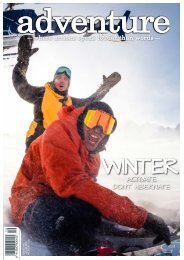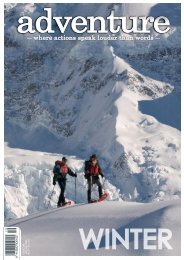Adventure Magazine Issue 220
Issue 220: June/July Winter 2020
Issue 220: June/July
Winter 2020
Create successful ePaper yourself
Turn your PDF publications into a flip-book with our unique Google optimized e-Paper software.
Above and below: Learning to interpret<br />
snowpack is an important tool in your<br />
avalanche awareness toolkit.<br />
• In New Zealand especially, flexibility is key.<br />
Have plans for a number of objectives ready<br />
to go. Then when the dates draw near, you’re<br />
able to choose the most appropriate trip for<br />
the given weather and conditions. Locking<br />
onto a single plan and stubbornly plunging<br />
forward regardless of the circumstances is a<br />
big red flag.<br />
• Be aware of the avalanche danger scale<br />
and the public danger forecast from the MSC<br />
NZ Avalanche Advisory before accessing<br />
the backcountry. This should be a given!<br />
When interpreting the danger forecast,<br />
make sure you consider the forecasted<br />
avalanche character; this will dictate which<br />
risk management strategies you should apply<br />
when you do head into the field.<br />
Terrain on Black Peak is for advanced skiers, with options for ski mountaineers to take it to the next level.<br />
• Make a realistic assessment of the team’s skills, experience and<br />
abilities. Ideally you’ll get to know the strengths and weaknesses of<br />
each team member through a progression of trips or other activities.<br />
Knowing what you each bring to the table increases confidence<br />
and ultimately safety. It’s also useful for individuals to have a clear<br />
understanding of their own goals and motivations, and how these fit in<br />
with the others on the team. Both these and levels of risk acceptance<br />
will be big factors in decision making during the planning and<br />
execution of a trip, and good teamwork is never a bad thing.<br />
• There is an inherent risk associated with any<br />
backcountry travel. In the event of an emergency,<br />
remember that weather and conditions in the mountains<br />
might prevent attempts at immediate rescue. Have plans<br />
in place and carry appropriate equipment to keep yourself<br />
as comfortable as possible during an extended stay in the<br />
elements, including the right emergency communication<br />
tools. How much and what you carry will depend on the<br />
level of commitment and remoteness of your journey.<br />
• Once your trip is finished and you’re back at<br />
home with a hot chocolate and epic photos, there<br />
is yet another step. Take some time to reflect on<br />
your trip, whether successful or not, and use this to<br />
inform your ongoing improvement in trip planning,<br />
movement, technical systems and all the other<br />
factors that contribute to a long and enjoyable career<br />
skiing in the backcountry. Then get onto planning<br />
your next adventure!<br />
30//WHERE ACTIONS SPEAK LOUDER THAN WORDS/#<strong>220</strong> ADVENTUREMAGAZINE.CO.NZ 31

















